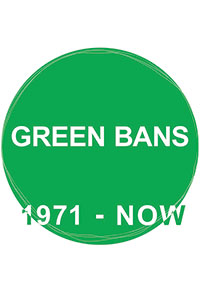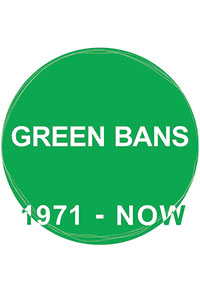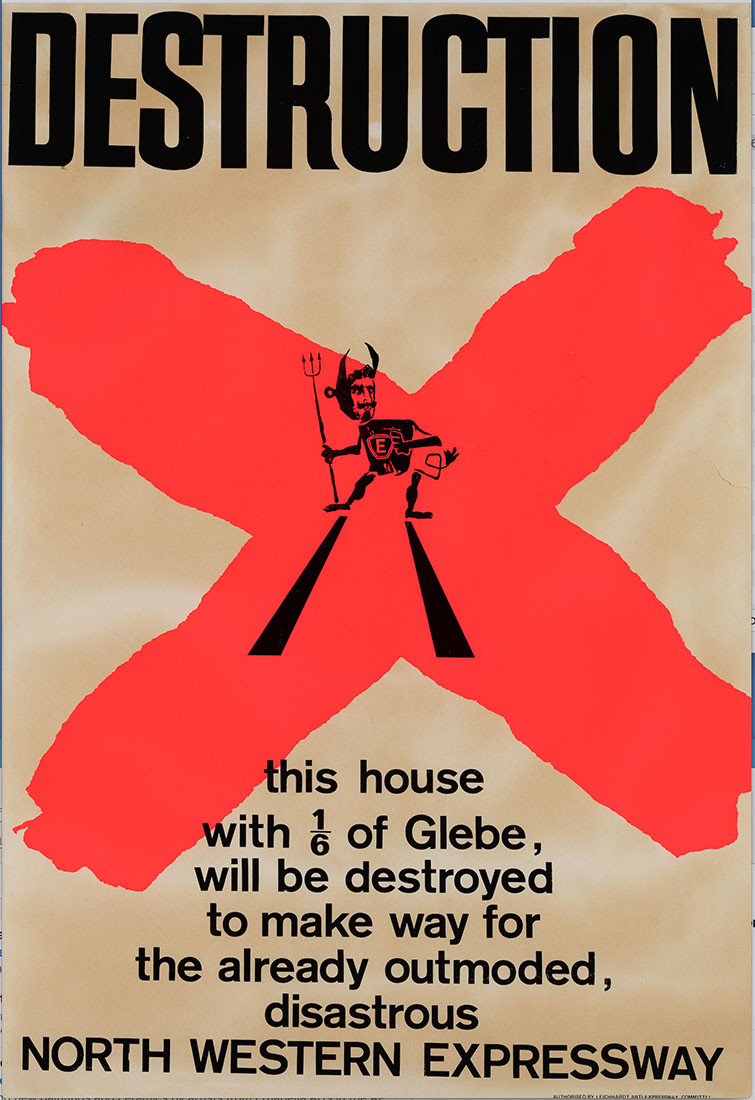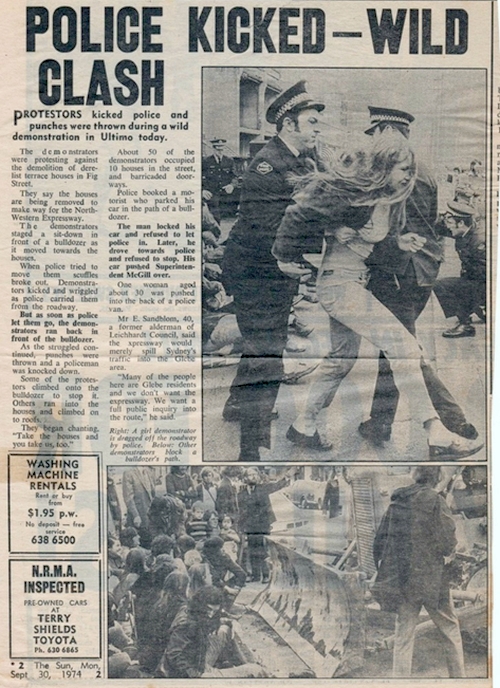North-West Expressway & the Battle of Fig Street, Ultimo, 1971-1975
The Glebe Society formed a Town Planning Sub-committee in 1969. The Roads group was to look closely into the Department of Main Roads expressway proposals. The proposed North Western Expressway was initially proposed as a tunnel between Palmerston Avenue and Maxwell Road, Glebe. Bernard Smith received an assurance from Mr Morton that “the North-Western expressway through Glebe … will be a driven tunnel”. It was indicated on the City of Sydney Planning Scheme as a tunnel. This would have alleviated the destruction caused by open cut construction.
By 1971 the Society’s Bulletin expressed strong opposition to expressways. The Society did not consider expressways worth the cost of the inevitable social disintegration and the irreplaceable historic fabric of a great city. They proposed alternative solutions to Sydney’s traffic problems such as: Parking stations at railway stations; Staggered business hours; More harbour crossings; Improvements to public transport; A major ring road system and Decentralisation.
In 1971 Albert Mispel wrote a passionate protest letter against the North Western expressway which would have involved the destruction of Lyndhurst House. By 1972 the Glebe Society joined forces with the Leichhardt Anti-Expressway Committee. In 1973 Leichhardt Council organised a meeting at Leichhardt Town Hall.
The Glebe Society, The Annandale Association, the Glebe Anti-Expressway Group and the Save Lyndhurst Committee wrote a joint letter to the Sydney Morning Herald (late 1973; re-published Glebe Society Bulletin 10 of 1973), reviewing “the conditions of two of the green bans enforced by the Builders’ Labourers’ Federation – the demolition of Lyndhurst and the construction of the North-Western Expressway.” Jack Mundey, Joe Owens and the NSW branch of the BLF were to prove valuable allies.
The DMR ignored the many protest motions passed by the Anti-Urban Radial Expressway Committee and continued to demolish houses which had been compulsorily resumed. Active protest came to a head in the battle of Fig Street which, as reported by Allan Sorrenson in the Bulletin No.2 (March) 1975, “ … saw hundreds of residents turning out in a spontaneous demonstration against the DMR’s policies. For one long week Fig Street, Ultimo was THE place to be. Residents, bulldozers, police, politicians and the media were there. Tension was high. Twelve people were arrested. But a real community spirit pervaded and the residents prevailed.” (See also Bulletin No.8 (October) of 1975, article by Allan Sorrenson, spokesman for the Save the Public Transport Committee and Senior Vice-President of the Glebe Society,)
The Glebe Society published series of occasional monographs that argued for alternative solutions to the expressways. Monograph No 1, by David Potter (ARMIT, B Sc ENG) was titled “An Alternative to Inner Urban Expressways”. Eric Sandblom, a Glebe Ward alderman on Leichhardt Council and an early convenor of the Society’s planning sub-committee, wrote the foreword. Monograph No 2, “A Northwestern Railway” by John Gerofi and Jim Coombs, proposed “a development of Sydney’s suburban electric railway system to serve the NorthWestern suburbs of the city …at a small fraction of the cost of the proposed expressway”. The plan envisaged an elaborate system of light rail connecting with the Eastern Suburbs Railway and running from the CBD through Ultimo, Glebe and Annandale to Leichhardt. Monograph No 3, “Better Public Transport in Sydney’s Inner Western & South-Eastern Suburbs” by Dr John Gerofi (1981), recommended “an integrated system of buses and Light Rail Transit (LRT) … a modern, fast, electric system/”
The election of the Wran government in 1976 brought a pause to the long-standing plans of the Department of Main Roads; (DMR), but in a publication by the Inner Sydney Regional Transport Group, “Stop Them Resurrecting Askin’s Freeways” (1986), Stephen Harris, Senior Lecturer in Town Planning, UNSW, stated that “the transport plans of the mid-1980s remain firmly based on those of the mid-1940s – because the DMR has a long memory and has talked the government around to the plans it has always had its heart set on”. (The DMR became the RTA, then Transport NSW.)
Freeways are now built by private enterprise and financed by the payment of tolls: such as the Cross City Tunnel and Western Distributor, leading to the prioritisation of motorised traffic and carcinogenic particulates from motor vehicle exhausts; noise pollution, social disruption caused by construction.
References
Excerpts from an article published in the Glebe Society Bulletin of November/December 2004. Complete set of Glebe Society Bulletins available for reading in the Glebe Library or See: The Glebe Society at https://glebesociety.org.au/the-glebe-society/contacts/
Groups active today: Action for Public Transport (founded 1974), see https://www.aptnsw.org.au/



